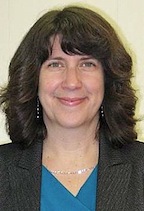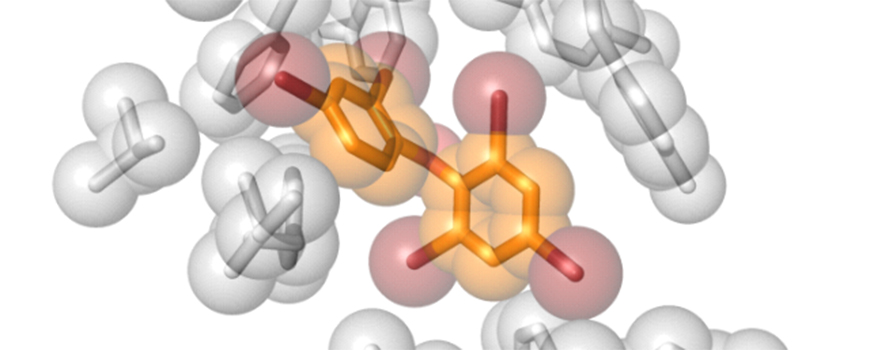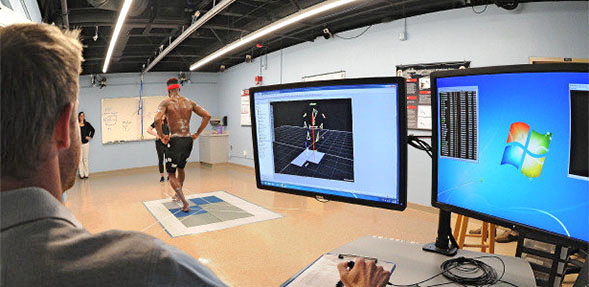Daily Business Report-April 19, 2016
A SDSU athlete tests the new program. (SDSU NewsCenter)
New Testing Has SDSU
On Top of its Game
Thanks to a collaboration between
academics and athletics,
a rehabilitation biomechanics lab
was hatched last spring
By Mick McGrane
GoAztecs.com Senior Writer
In a space that once served as the Peterson Gym concession stand, Zylan Cheatham, clad only in shorts and sneakers, looks infinitely more like The Six Million Dollar Man than San Diego State power forward.
Affixed to Cheatham’s body are 75 reflective markers positioned to work in tandem with 16 infrared cameras. Part of a 3D motion capture system common to all video games, the cameras will catalog Cheatham’s every move as he performs four sports-specific tasks measuring not only forces acting upon the body, but also serving to identify precursors to potential injury.
Over the course of the next 60 minutes, the cameras will generate more than 19,000 images of Cheatham’s movements as he squats, hops, jumps and undergoes balance testing atop a series of five force plates, each costing approximately $15,000.
This is the science of sports biomechanics, or the physics of sports. A collaboration between academics and athletics, the idea to turn a former hot dog stand into a rehabilitation biomechanics lab was hatched last spring when Sara Gombatto, an assistant professor in the university’s Doctor of Physical Therapy program, met with Tom Abdenour, SDSU’s head athletic trainer.
Clearly, Abdenour, who just completed his fifth season at SDSU, is in rare company. Having spent nearly 40 years mastering his craft, including 24 seasons in the NBA and as a member of the U.S. Olympic Team’s medical staff in 2000, Abdenour’s praises are sung loudly and often by Aztecs Coach Steve Fisher. A man who relies as much on evidence-based science as he does Epsom salts, he was once referred to as a “magician” by former SDSU player Garrett Green.
Yet when Gombatto, who has a Ph.D. in movement science, approached Abdenour last year about joining forces to enhance athletic performance and identify dysfunctions that could lead to injury, the result was the creation of a program involving research practices being utilized nowhere else in San Diego or the Mountain West.
“Tom and I started working together, because there is a lot of evidence in the (sports medicine) literature to support what kind of things can contribute to injury,” Gambotto said. “What are the risk factors? But the problem is, it isn’t often translated into practice.
“So I approached Tom and said, ‘What do you say we start a program where we can start screening our athletes to compare their measures to those in the literature and see who’s at risk, identify those people and then decide on maybe changing their strength and conditioning program or change things during their rehab? Then, when we do have an athlete who’s injured, who’s gone through rehab, let’s test them and see what their measures are again and see if they’re ready to return.’”
Exhibit A? Junior wing Matt Shrigley, who was one of the first two student-athletes to be tested by Gombatto and Abdenour last fall. Whereas even elite athletes can require eight months to return from reconstructive knee surgery, Shrigley, who underwent such a procedure after suffering a torn anterior cruciate ligament in his right knee in July, was back in five, making his first appearance against Utah State on Jan. 23. And while he did not score, much to the chagrin of those wanting the fairy tale to end in the usual fashion, Shrigley’s zero in the box score was nothing but a bonus in the eyes of Fisher.
“I love Matt Shrigley,” Fisher said. “From the moment he had the surgery, he was committed to whatever he had to do to get himself ready to play. We all feel sorry for ourselves, and I’m sure he did for a period of time after he found out he had the ACL injury. But he worked so hard.”
Work done under the watchful eyes of Gombatto and Abdenour, who will retest Shrigley this fall. Others who will be closely monitored, Abdenour said, are transfers Max Hoetzel and Montaque “Teki” Gill-Caesar, both of whom have undergone knee surgeries in the past. Cheatham redshirted his freshman season after suffering a broken bone in his foot.
“We’re in a gold mine here with our student-athletes and their aches and pains,” Abdenour said. “We’re just tapping into it so we can try and prevent (injuries).”
And not just injuries to men’s basketball players. While sports biomechanics research and applications run the gamut from track and field to the trampoline, it’s Gombatto’s hope that the program will ultimately include the majority of SDSU student-athletes. Gombatto and Abdenour hope to have concluded initial testing of the entire men’s basketball roster by the end of the week, at which point measurements of strengths and weaknesses can be relayed to strength and conditioning coach Randy Shelton.
“Our long-term vision is to expand this to our other teams,” said Gombatto, the lab’s co-director. “I think a lot of it depends on the individual trainer, as well as the strength and conditioning coaches and the players. I think it’s really important that we’re all going over this together, with each individual giving their own perspective.
“There aren’t a lot of people who are trying to do this. Most of the time people stay on the research side or stay on the clinical side, because it’s hard. You have to have willing and able collaborators to pull something like this off. Tom’s expertise is invaluable. As soon as I approached him about doing this, he knew exactly what I was talking about and what I wanted to do. He doesn’t know about biomechanics analysis, but he knows how to relate the information to the kids and to the surgeons and he knows where a particular player fits into the team. He knows their (physical) history, as well.
“Tom and I really wanted to do something that was general enough to cover a variety of lower-extremity injuries like an ACL tear, patellar tendinitis, chronic ankle instability, hip injuries and the spine. Tom has been on the cutting edge. He’s doing the standardized testing that’s in the (sports medicine) literature. He’s doing everything he can with the tools that are available to him. Now that we’ve added those tools to the biomechanics expertise that I have, we can enhance what Tom has already been doing.”
Even if it never culminates in a certain San Diego State power being transformed into The Six Million Dollar Man.
“I have a little different way of watching the team play during the season, because I’m watching their movements and body mechanics,” Gombatto said. “I’m watching as a biomechanist, but I’m also watching as a fan. It’s hard to separate the two.”
No harder, apparently, than turning a hot dog stand into a vision of the future.
— SDSU NewsCenter
____________________________________________
San Diego’s Biocom Expands to L.A.
With Dina Lozofsky Heading Office
By City News Service
Biocom, the San Diego-based organization that represents 750 Southern California life science industry companies, announced Monday the establishment of a Los Angeles office.

“Biocom’s goal in Los Angeles is to accelerate the growth of a thriving, dynamic life sciences community, leveraging the many building blocks already in place,” said a Biocom statement.
Dina Lozofsky, who was named executive director of the Los Angeles operation, has more than two decades of experience in the science and technology industries of Southern California.
Lozofsky has been on the board of directors of Los Angeles Venture Association since July 2015, said her LinkedIn profile.
She was associate director for licensing and business development at UC Santa Barbara’s Office of Technology & Industry Alliances for six years.
According to Biocom, nearly 300 biopharmaceutical and medical device companies are headquartered in Los Angeles County, in addition to teaching hospitals and biomedical research organizations.
The area “also boasts a highly skilled talent pool of life science graduates,” many with advanced degrees, according to Biocom.
“Los Angeles as a region has enormous potential to unify and thrive as a successful life science cluster,” said Biocom President and CEO Joe Panetta. “As we listen to the needs of the industry, we see activities and programs we can introduce, and best practices we can offer, to promote the success of L.A. as a life science powerhouse.
“Our long-term goal is to bring a strong, cohesive voice that advocates for the industry, venture capital funding, regulatory pathways, partnerships, technology transfer and talent retention,” he said. “We recognize a trend of entrepreneurs taking innovations they discovered in Los Angeles to companies in other parts of the country for further development and commercialization.”

Study: Pollutants in Fish Inhibit
Humans’ Natural Defense System
In a new study, environmental pollutants found in fish were shown to obstruct the human body’s natural defense system to expel harmful toxins. The Scripps Institution of Oceanography at UC San Diego-led research team suggests that this information should be used to better assess the human health risks from eating contaminated seafood. The study was published in the April 15 issue of the journal Science Advances.
A protein found in cells of nearly all plants and animals, called P-gp, acts as the cell’s bouncer by expelling foreign chemicals from the body. P-gp is well known for its ability to transport therapeutic drugs out of cancer cells and, in some cases, rendering these cells resistant to multiple drugs at once.
To determine how effective P-gp is at ridding cells of industrial and agricultural pollutants found in seafood, collectively known as persistent organic pollutants (POPs), the Scripps research team conducted a biochemical analysis of P-gp proteins from humans and mice against POPs. The scientists focused on POPs most commonly found in human blood and urine, and also detected in the muscle tissues of wild-caught yellowfin tuna. The pollutants included older “legacy” compounds such as the pesticide DDT as well as newer industrial chemicals, such as flame retardants.
Working with researchers at UC San Diego’s Skaggs School of Pharmacy and Pharmaceutical Science and School of Medicine, the researchers discovered that all 10 pollutants interfered with the ability of P-gp to protect cells. The study was also the first to show how one of the 10 pollutants, PBDE-100, commonly used as a flame retardant in upholstery foam and plastics, binds to the transporter protein. The POP binds to the protein in a similar way as chemotherapeutics and other drugs, but instead of being transported out of the cell, the bound POP ultimately inhibits the protein’s ability to perform its defense function.
“We show that these inhibitors are found in the fish we eat,” said Scripps postdoctoral researcher Sascha Nicklisch, lead author of the study. “The concentrations in the fat of some tuna were high enough to inhibit P-gp in our assays. Therefore, it is important to consider the potential risk of dietary intake of these pollutants.”
The researchers point out that newborns and fish larvae are two of the most vulnerable populations. Newborns are particularly vulnerable since they are exposed to high concentrations of POPs in breast milk, and have low amounts of the protective P-gp protein. Fish larvae may be at increased risk since the accumulation of pollutants may slow down the animal’s defense system to combat other marine pollutants, such as oil hydrocarbons encountered at oil spill sites.
“When we eat contaminated fish, we could be reducing the effectiveness of this critical defense system in our bodies,” said Amro Hamdoun, an associate professor in the Marine Biology Research Division at Scripps, and senior author of the study.
The Scripps researchers suggest that environmental chemicals should be tested to determine if they impede the effectiveness of the body’s natural defense system to expel these, and other foreign chemicals. The U.S. Food and Drug Administration currently recommends similar testing on pharmaceuticals.
“It’s unsettling to find that all of the tested persistent environmental pollutants interfered with the protein’s ability to protect cells,” said Jacob James, managing director of the Waitt Foundation, who funded the study. “Even more troubling are the results showing that PBDE-100 binds to the protein, in essence latching onto and poisoning the ‘bouncer’ whose job it is to throw out the toxins. We can assume that some ‘hot’ fish carry more than one toxin and that seems like a credible triple threat, as the results with mixtures suggest that multiple toxins do act as ‘force multipliers’ in degrading cells ability to respond. We are the only species that can influence entire food chains and habitats, we must act more responsibly in the design and use of chemicals in our environment as well as work on economically feasible ways to measure and understand the impacts of those chemicals in seafood, and ourselves.”
The National Institute of Environmental Health Sciences, Waitt Foundation, and National Science Foundation funded the study. Researchers from Sekisui XenoTech, LLC also contributed to the research study.



